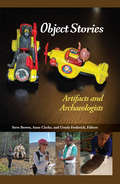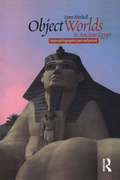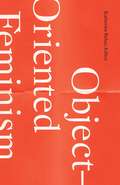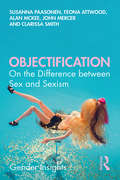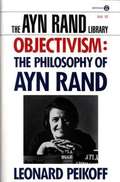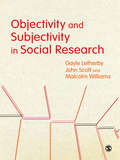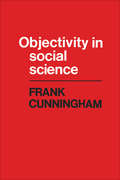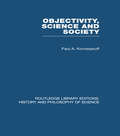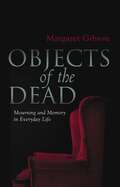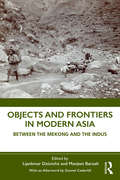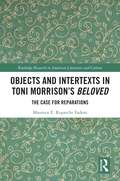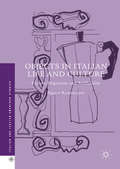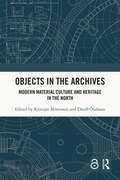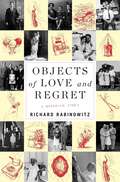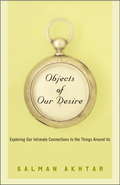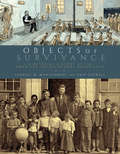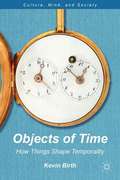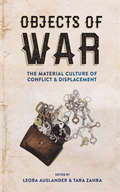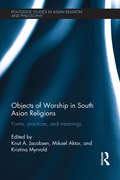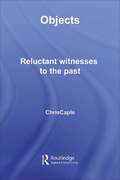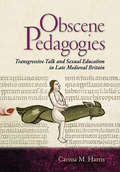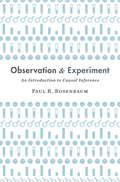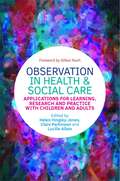- Table View
- List View
Object Management (Routledge Revivals)
by Roger Tagg June MabonFirst published in 1992, this volume explores the use of object oriented methods which is forecast to grow rapidly, with their flexibility and facility to overcome some of the inadequacies of relational databases. This timely book reviews their potential in the data management context. It examines the impact of object oriented techniques on the practice of data management including data analysis, database design, database administration and DBMS operation. The main emphasis of the book is on practical experience of developing and applying 00 methods in the most popular application areas. Its four parts covering the background to object technology, the products, the applications and the implications.
Object Stories: Artifacts and Archaeologists
by Steve Brown Anne Clarke Ursula FrederickArchaeologists are synonymous with artifacts. With artifacts we construct stories concerning past lives and livelihoods, yet we rarely write of deeply personal encounters or of the way the lives of objects and our lives become enmeshed. In this volume, 23 archaeologists each tell an intimate story of their experience and entanglement with an evocative artifact. Artifacts range from a New Britain obsidian tool to an abandoned Viking toy boat, the marble finger of a classical Greek statue and ordinary pottery fragments from Roman England and Polynesia. Other tales cover contemporary objects, including a toothpick, bell, door, and the blueprint for a 1970s motorcar. These creative stories are self-consciously personal; they derive from real world encounter viewed through the peculiarities and material intimacy of archaeological practice. This text can be used in undergraduate and graduate courses focused on archaeological interpretation and theory, as well as on material culture and story-telling.
Object Worlds in Ancient Egypt: Material Biographies Past and Present (Materializing Culture)
by Lynn MeskellEgypt looms large in the Western imagination. Whether it is our attraction to pharaonic art, the pyramids or practices of mummification, Egypts unique understanding of materiality speaks to us across space and time. Is it because the ancient Egyptians fetishized material objects that we find their culture captivating today? And what exactly do Egyptian remains tell us about biography, embodiment, memory, materiality, and the self? Object Worlds in Ancient Egypt takes New Kingdom Egypt (1539-1070 BC) as its starting point and considers how excavated objects reveal the complex ways that ancient Egyptians experienced their material world. From life to death, the material world instantiated, reflected and influenced social life and existence for ancient Egyptians. Thus, in Meskells unique approach to the materiality and sensuousness of subjects and objects, we uncover the philosophical, spiritual and human meanings embedded in these cultural artefacts. Meskells book explores the fundamental existential questions that not only preoccupied ancient Egyptians, but continue to fascinate people today. What is the essence of persons and things? How might we understand the situated experiences of material life, the constitution of the object world and its shaping of human experience? How might objects successfully mediate between worlds? In the final analysis, Meskell moves forward through time and examines the consumption and appreciation of these Egyptian material objects in the contemporary world. Materiality is our physical engagement with the world, our medium for inserting ourselves into the fabric of that world and our way of constituting and shaping culture in an embodied and external sense. From that perspective it is very much the domain of anthropology and archaeology.Drawing on a wide range of objects, artefacts, and artwork, from Valley of the Kings through to Las Vegas, Meskell provides an elegant analysis of the aesthetics of ancient Egyptian material culture
Object-Oriented Feminism
by Katherine BeharThe essays in Object-Oriented Feminism explore OOF: a feminist intervention into recent philosophical discourses—like speculative realism, object-oriented ontology (OOO), and new materialism—that take objects, things, stuff, and matter as primary. Object-oriented feminism approaches all objects from the inside-out position of being an object too, with all of its accompanying political and ethical potentials. This volume places OOF thought in a long history of ongoing feminist work in multiple disciplines. In particular, object-oriented feminism foregrounds three significant aspects of feminist thinking in the philosophy of things: politics, engaging with histories of treating certain humans (women, people of color, and the poor) as objects; erotics, employing humor to foment unseemly entanglements between things; and ethics, refusing to make grand philosophical truth claims, instead staking a modest ethical position that arrives at being &“in the right&” by being &“wrong.&”Seeking not to define object-oriented feminism but rather to enact it, the volume is interdisciplinary in approach, with contributors from a variety of fields, including sociology, anthropology, English, art, and philosophy. Topics are frequently provocative, engaging a wide range of theorists from Heidegger and Levinas to Irigaray and Haraway, and an intriguing diverse array of objects, including the female body as fetish object in Lolita subculture; birds made queer by endocrine disruptors; and truth claims arising in material relations in indigenous fiction and film. Intentionally, each essay can be seen as an &“object&” in relation to others in this collection. Contributors: Irina Aristarkhova, University of Michigan; Karen Gregory, University of Edinburgh; Marina Gržinić, Slovenian Academy of Science and Arts; Frenchy Lunning, Minneapolis College of Art and Design; Timothy Morton, Rice University; Anne Pollock, Georgia Tech; Elizabeth A. Povinelli, Columbia University; R. Joshua Scannell, CUNY Graduate Center; Adam Zaretsky, VASTAL.
Objectification: On the Difference between Sex and Sexism (Gender Insights)
by Clarissa Smith Feona Attwood John Mercer Alan McKee Susanna PaasonenThis is a concise and accessible introduction into the concept of objectification, one of the most frequently recurring terms in both academic and media debates on the gendered politics of contemporary culture, and core to critiquing the social positions of sex and sexism. Objectification is an issue of media representation and everyday experiences alike. Central to theories of film spectatorship, beauty fashion and sex, objectification is connected to the harassment and discrimination of women, to the sexualization of culture and the pressing presence of body norms within media. This concise guidebook traces the history of the term’s emergence and its use in a variety of contexts such as debates about sexualization and the male gaze, and its mobilization in connection with the body, selfies and pornography, as well as in feminist activism. It will be an essential introduction for undergraduate and postgraduate students in Gender Studies, Media Studies, Sociology, Cultural Studies or Visual Arts.
Objectivism: The Philosophy of Ayn Rand (Ayn Rand Library)
by Leonard PeikoffTHE 25TH ANNIVERSARY EDITION—The definitive statement of Ayn Rand&’s philosophy as interpreted by her best student and chosen heir. This brilliantly conceived and organized book is Dr. Leonard Peikoff&’s classic text on the abstract principles and practical applications of Objectivism, based on his lecture series &“The Philosophy of Objectivism.&” Ayn Rand said of these lectures: &“Until or unless I write a comprehensive treatise on my philosophy, Dr. Peikoff&’s course is the only authorized presentation of the entire theoretical structure of Objectivism—that is, the only one that I know of my knowledge to be fully accurate.&” In Objectivism, Peikoff covers every philosophic topic that Rand regarded as important—from certainty to money, from logic to art, from measurement to sex. Drawn from Rand&’s published works as well as in-depth conversations between her and Peikoff, these chapters illuminate Objectivism—and its creator—with startling clarity. With Objectivism, the millions of readers who have been transformed by Atlas Shrugged and The Fountainhead will discover the full philosophical system underlying Ayn Rand&’s work.
Objectivity and Subjectivity in Social Research
by John Scott Matthew Williams Gayle LetherbyObjectivity and subjectivity are key concepts in social research. This book, written by leading authors in the field, takes a completely new approach to objectivity and subjectivity, no longer treating them as opposed - as many existing texts do - but as logically and methodologically related in social research. The book debates: - the philosophical bases of objectivity and relativity - relationism and dynamic synthesis - situated objectivity - theorised subjectivity - social objects and realism - objectivity and subjectivity in practice The authors explain complex arguments with great clarity for social science students, while also providing the detail and comprehensiveness required to meet the needs of practising researchers and scholars.
Objectivity in Social Science
by Frank CunninghamThe debates over objectivity in the social sciences have a long history; there have been contributions by philosophers and social theorists from a variety of viewpoints, including empiricism, phenomenology, pragmatism, and Marxism. Objectivity in Social Science combats the widespread opinion that objective inquiry is impossible in the social sciences by drawing together and exhibiting the weaknesses of arguments, taken from positions in the philosophies of science, social science, language, and perception, in favour of anti-objectivism, arguments which have recurred in one form or another throughout the course of these debates. As the author puts it, 'What I have attempted to offer is at the least a convenient map for finding one's way about in the tangle of issues surrounding the question of objectivity in social science and at the most a set of arguments sufficient to convince the perplexed, and presently wrong-headed, of the (objective) falsity of social-scientific anti-objectivism.' In the course of the book arguments advanced by such influential figures as Thomas Kuhn, Benjamin Lee Whorf, Karl Mannheim, N.R. Hanson, Peter Winch, Michael Polanyi, P.K. Feyerabend, and Jürgen Habermas, among others, are critically examined, as are attempts of pragmatists, phenomenologists, and others to construct alternatives to the objectivist interpretation of conflict and progress in the development of social-scientific knowledge.
Objectivity, Science and Society: Interpreting nature and society in the age of the crisis of science (Routledge Library Editions: History & Philosophy of Science)
by Paul A KomesaroffOriginally published in 1986. This work remains of compelling interest to those concerned with the natural sciences and their social problems. It puts forward original and unorthodox ideas about the philosophy of and sociology of science, starting from the conviction that modern societies face deep problems arising from unresolved dilemmas about the meaning, content and technical applications of the theories of nature they employ. The book draws on insights developed within a variety of traditions to explore these problems, especially the work of Edmund Husserl and modern critical theory.
Objects Of The Dead: Mourning And Memory In Everyday Life
by Margaret GibsonWhat is the fate of objects after a death-a daughter's hairbrush, a father's favourite chair, an aunt's earrings, a husband's clothes? Why do some things stay and some go from our lives and memories? Objects of the Dead examines a poignant and universal experience-the death of a loved one and the often uneasy process of living with, and discarding, the objects that are left behind. How and when family property is sorted through after a death is often fraught with difficulties, regrets and disagreements. Through personal stories, literature, film and memoir Margaret Gibson reveals the power of things to bind and undo relationships. This is a remarkable reflection on grieving-of both saying goodbye and living with death.
Objects and Frontiers in Modern Asia: Between the Mekong and the Indus
by Lipokmar Dzüvichü Manjeet BaruahFocusing on the geographies between the Mekong and the Indus, this book brings objects to the centre of enquiry in the understanding of modern Asian frontiers. It explores how a range of objects have historically been significant bearers and agents of frontier making. For instance, how are objects connected to aspects of state making, social change, everyday life, diplomacy, political and ecological worlds, capital, forms of violence, resistances, circulations, and aesthetic expressions? This book seeks to interrogate and understand the dynamism of frontiers from the vantage point of objects such as salt, rubber, tea, guns, silk scarves, horses, and opium. It attempts to explore objects as sites of encounter, mediation, or dislocation between the social and the spatial. The book not only locates objects in the specificities of frontier spaces, but it also looks at how they are produced, circulated, and come to be intricately linked to a wide range of people, institutions, networks, and geographies. In the process, it explores how objects traverse and come to inhabit multiple historical, cultural, and geographical scales. This book will be of interest to researchers and academics working in areas of history, social and cultural anthropology, Asian studies, frontiers and borderland studies, cultural studies, political and economic studies, and museum studies.
Objects and Intertexts in Toni Morrison’s "Beloved": The Case for Reparations (Routledge Research in American Literature and Culture)
by Maureen E. FademObjects and Intertexts in Toni Morrison’s “Beloved”: The Case for Reparations is an inspired contribution to the scholarship on one of the most influential American novels and novelists. The author positions this contemporary classic as a meditation on historical justice and re-comprehends it as both a formal tragedy— a generic translation of fiction and tragedy or a “novel-tragedy” (Kliger)—and a novel of objects. Its many things—literary, conceptual,linguistic— are viewed as vessels carrying the (hi)story and the political concerns. From this, a third conclusion is drawn: Fadem argues for a view of Beloved as a case for reparations. That status is founded on two outstanding object lessons: the character of Beloved as embodiment of the subject-object relations defining the slave state and the grammatical object “weather” in the sentence “The rest is…” on the novel’s final page. This intertextual reference places Beloved in a comparative link with Hamlet and Oresteia. Fadem’s research is meticulous in engaging the full spectrum of tragedy theory, much critical theory, and a full swathe of scholarship on the novel. Few critics take up the matter of reparations, still fewer the politics of genre, craft, and form. This scholar posits Morrison’s tragedy as constituting a searing critique of modernity, as composed through meaningful intertextualities and as crafted by profound “thingly” objects (Brown). Altogether, Fadem has divined a fascinating singular treatment of Beloved exploring the connections between form and craft together with critical historical and political implications. The book argues, finally, that this novel’s first concern is justice, and its chief aim to serve as a clarion call for material— and not merely symbolic—reparations.
Objects in Italian Life and Culture
by Paolo BartoloniThis book makes visible the hidden relations between things and individuals through a discussion of creative processes and cultural practices. Italian life and culture are filled with objects that cross, accompany, facilitate or disrupt experience, desires, and dreams. Yet in spite of their ubiquity, theoretical engagement in the Italian context is still underdeveloped. Paolo Bartoloni investigates four typologies--the fictional, migrant, multicultural/transnational, and the artificial--to hypothesize that the ability to treat things as partners of emotional and creative expression creates a sense of identity predicated on inclusivity, openness, care, and attention.
Objects in the Archives: Modern Material Culture and Heritage in the North
by Kristján Mímisson Davíð ÓlafssonSituated on an intersection between Material Culture Studies, History and Museum and Archival Studies, this book investigates the material world of the Icelandic population in the late Modern Era.Utilizing the great wealth of inventories of household goods stored at The National Archives of Iceland in conjunction with material objects, the book highlights new paths and insights into understanding people’s possessions and material relations, and the entwined biographies of people and things. It shows how people shaped their own lives by means of things and how these material relations are “archived” and represented in heritage and museum spaces. The book is divided into two parts that explore how material culture contributes to history, the relationship between things and text, and the practice of collecting things and address the process of assembly, or how things gather. Micro and macro methods of investigation tease out new approaches to debates around human–thing relationships, acknowledging ideas about material agency and social significance and that the human–material relation is reciprocal.This volume will appeal to students and researchers within the field of archaeology, material culture studies, museum studies, heritage, and the history of material culture.
Objects of Love and Regret: A Brooklyn Story
by Richard RabinowitzAn award-winning historian and museum curator tells the story of his Jewish immigrant family by lovingly reconstructing its dramatic encounters with the memory-filled objects of ordinary life.At a pushcart stall in East New York, Brooklyn, in the spring of 1934, eighteen-year-old Sarah Schwartz bought her mother, Shenka, a green, wooden-handled bottle opener. Decades later, Sarah would tear up telling her son Richard, “Your bubbe always worked so hard. Twenty cents, it cost me.”How could that unremarkable item, and others like it, reveal the untold history of a Jewish immigrant family, their chances and their choices over the course of an eventful century? By unearthing the personal meaning and historical significance of simple everyday objects, Richard Rabinowitz offers an intimate portrait connecting Sarah, Shenka, and the rest of his family to the twentieth-century transformations of American life. During the Depression, Sarah—born on a Polish battlefield in World War I, scarred by pogroms, pressed too early into adult responsibilities—receives a gift of French perfume, her fiancé Dave’s response to the stigma of poverty. Later we watch Dave load folding chairs into his car for a state-park outing, signaling both the postwar detachment from city life and his own escape from failures to be a good “provider” for those he loves.Objects of Love and Regret is closely wedded to the lives of American Jewish immigrants and their children, yet Rabinowitz invites all of us to contemplate the material world that anchors our own memories. Beautifully written, absorbing, and emotionally vivid, this is a memoir that brings us back to the striving, the dreams, the successes, and the tragedies that are part of every family’s story.
Objects of Our Desire
by Salman AkhtarWhat makes something sexy? Why are some things regarded as sacred and others profane? Why do mourners face such difficulty in parting with their beloved’s possessions? Why do we often feel distraught when we lose something, even when the object has little real value? We spend our lives in a meaningful dialogue with things around us. Sometimes the conversation is loud, as in a collector’s passion for coins or art. More often, the exchange is subtle and muted, even imperceptible. We are surrounded by things, and they affect our emotions and impact our thoughts. The arrival of a dozen flowers from a lover or a letter from a grandchild makes our day; an old photo album or an afghan knitted by a favorite aunt offers comfort when we are troubled. From exploring what makes something “beautiful” to why we place such value on antiques and artifacts from the past,Objects of Our Desireoffers insights, both deep and delightful, into the ways we invest things with meaning and the powerful roles they play in our lives. Noticethe inviting contours of that sofa, the glint of a knife’s edge, the sparkle of a diamond ring. Feel the softness of the pashmina around that woman’s milky shoulders. Look at the majesty of a large jet plane. Take in the somberness of a gravestone. Put on an old pair of shoes. Clutch a warm mug of freshly brewed coffee. Sit on a rocking chair. Feel the sumptuous leather seats of a new car. We are surrounded by things. We are involved with them, indebted to them. We speak to things and things speak to us. To say that we are interdependent is banal. Let us be courageous. Let us admit it: we are lovers. —FromObjects of Our Desire
Objects of Survivance: A Material History of the American Indian School Experience
by Chip Colwell Lindsay M. MontgomeryBetween 1893 and 1903, Jesse H. Bratley worked in Indian schools across five reservations in the American West. As a teacher Bratley was charged with forcibly assimilating Native Americans through education. Although tasked with eradicating their culture, Bratley became entranced by it—collecting artifacts and taking glass plate photographs to document the Native America he encountered. Today, the Denver Museum of Nature & Science’s Jesse H. Bratley Collection consists of nearly 500 photographs and 1,000 pottery and basketry pieces, beadwork, weapons, toys, musical instruments, and other objects traced to the S’Klallam, Lakota Sioux, Cheyenne, Arapaho, Havasupai, Hopi, and Seminole peoples. This visual and material archive serves as a lens through which to view a key moment in US history—when Native Americans were sequestered onto reservation lands, forced into unfamiliar labor economies, and attacked for their religious practices. Education, the government hoped, would be the final tool to permanently transform Indigenous bodies through moral instruction in Western dress, foodways, and living habits. Yet Lindsay Montgomery and Chip Colwell posit that Bratley’s collection constitutes “objects of survivance”—things and images that testify not to destruction and loss but to resistance and survival. Interwoven with documents and interviews, Objects of Survivance illuminates how the US government sought to control Native Americans and how Indigenous peoples endured in the face of such oppression. Rejecting the narrative that such objects preserve dying Native cultures, Objects of Survivance reframes the Bratley Collection, showing how tribal members have reconnected to these items, embracing them as part of their past and reclaiming them as part of their contemporary identities. This unique visual and material record of the early American Indian school experience and story of tribal perseverance will be of value to anyone interested in US history, Native American studies, and social justice. Co-published with the Denver Museum of Nature & Science
Objects of Time
by Kevin K. BirthThis is a book about time, but it is also about much more than time--it is about how the objects we use to think about time shape our thoughts. Because time ties together so many aspects of our lives, this book is able to explore the nexus of objects, cognition, culture, and even biology, and to do so in relationship to globalization.
Objects of War: The Material Culture of Conflict and Displacement
by Tara Zahra Leora AuslanderHistorians have become increasingly interested in material culture as both a category of analysis and as a teaching tool. And yet the profession tends to be suspicious of things; words are its stock-in-trade. What new insights can historians gain about the past by thinking about things? A central object (and consequence) of modern warfare is the radical destruction and transformation of the material world. And yet we know little about the role of material culture in the history of war and forced displacement: objects carried in flight; objects stolen on battlefields; objects expropriated, reappropriated, and remembered.Objects of War illuminates the ways in which people have used things to grapple with the social, cultural, and psychological upheavals wrought by war and forced displacement. Chapters consider theft and pillaging as strategies of conquest; soldiers' relationships with their weapons; and the use of clothing and domestic goods by prisoners of war, extermination camp inmates, freed people, and refugees to make claims and to create a kind of normalcy.While studies of migration and material culture have proliferated in recent years, as have histories of the Napoleonic, colonial, World Wars, and postcolonial wars, few have focused on the movement of people and things in times of war across two centuries. This focus, in combination with a broad temporal canvas, serves historians and others well as they seek to push beyond the written word.Contributors:Noah Benninga, Sandra H. Dudley, Bonnie Effros, Cathleen M. Giustino, Alice Goff, Gerdien Jonker, Aubrey Pomerance, Iris Rachamimov, Brandon M. Schechter, Jeffrey Wallen, and Sarah Jones Weicksel
Objects of Worship in South Asian Religions: Forms, Practices and Meanings
by Knut A. Jacobsen Kristina Myrvold Mikael AktorObjects of worship are an aspect of the material dimension of lived religion in South Asia. The omnipresence of these objects and their use is a theme which cuts across the religious traditions in the pluralistic religious culture of the region. Divine power becomes manifest in the objects and for the devotees they may represent power regardless of religious identity. This book looks at how objects of worship dominate the religious landscape of South Asia, and in what ways they are of significance not just from religious perspectives but also for the social life of the region. The contributions to the book show how these objects are shaped by traditions of religious aesthetics and have become conceptual devices woven into webs of religious and social meaning. They demonstrate how the objects have a social relationship with those who use them, sometimes even treated as being alive. The book discusses how devotees relate to such objects in a number of ways, and even if the objects belong to various traditions they may attract people from different communities and can also be contested in various ways. By analysing the specific qualities that make objects eligible for a status and identity as living objects of worship, the book contributes to an understanding of the central significance of these objects in the religious and social life of South Asia. It will be of interest to students and scholars of Religious Studies and South Asian Religion, Culture and Society.
Objects: Reluctant Witnesses to the Past
by Chris CapleAn invaluable field textbook, Objects examines detailed case studies to provide a brilliantly clear and comprehensible guide to the different methods and approaches (cultural, forensic, and technical) which can and have been used to study ancient artefacts. From the Bayeux Tapestry to small medieval brass pins, medieval wooden doors to Saxon jewellery, Chris Caple’s integral text deals with a full range of materials and clearly and simply explains key scientific techniques, technology, anthropological jargon and historical approaches. Key demonstrations include: how information from objects builds into a picture of the ancient society that made and used it the commonly used scientific techniques for object analysis how and why object typologies work how cultural and economic factors as well as the material properties influences what objects are made of how simple observation of an object can build its biography. Revealing answers to crucial questions – such as: Can DNA be obtained from objects? Why do people x-ray ancient artefacts? Can you determine the source of metal objects from their trace elements? – Objects is an absolutely essential text for students of archaeology, museum studies, and conservation.
Obscene Pedagogies: Transgressive Talk and Sexual Education in Late Medieval Britain
by Carissa M. HarrisAs anyone who has read Chaucer’s Canterbury Tales knows, Middle English literature is rife with sexually explicit language and situations. Less canonical works can be even more brazen in describing illicit acts of sexual activity and sexual violence. Such scenes and language were not, however, included exclusively for titillation. In Obscene Pedagogies, Carissa M. Harris argues instead for obscenity’s usefulness in sexual education. She investigates the relationship between obscenity, gender, and pedagogy in Middle English and Middle Scots literary texts from 1300 to 1580 to show how sexually explicit and defiantly vulgar speech taught readers and listeners about sexual behavior and consent.Through innovative close readings of literary texts including erotic lyrics, single-woman’s songs, debate poems between men and women, Scottish insult poetry battles, and The Canterbury Tales, Harris demonstrates how through its transgressive charge and galvanizing shock value, obscenity taught audiences about gender, sex, pleasure, and power in ways both positive and harmful. She focuses in particular on understudied female-voiced lyrics and gendered debate poems, many of which have their origin in oral culture, and includes teaching-ready editions of fourteen largely unknown anonymous lyrics in women’s voices. Harris’s own voice, proudly witty and sharply polemical, inspires the reader to address these medieval texts with an eye on contemporary issues of gender, violence, and misogyny.
Obscene Traffic: Prostitution and Global Migrations from the Italian Perspective (1890–1940) (Routledge Studies in Modern European History)
by Laura SchettiniThis book explores the early globalization of prostitution from the perspective of the Italian case. It is a story of prostitution, migration, and work, built through analyses of primary sources (the Italian archive of International Police) and covering a wide chronological period, from the end of the nineteenth century through the Second World War. It is the story of Giuseppa, Virginia, and many others who embarked from Italian ports in the 1890s to work in brothels in Egypt, Libya, and Malta, but also that of Marguerite, one of the numerous foreign prostitutes working in Italy in the 1930s. It is the story of Mariella, forced by her husband Beniamino to work as a prostitute in the United States while pregnant in the 1900s, of Francesco, who on the eve of the Second World War recruited young natives to work in his cabarets in Panama. It is the story of a passionate diplomat committed to the League of Nations’ fight against the white slave traffic but also of police officers, consuls, and ministers more concerned about their nation’s reputation than women’s rights. This book, aimed at students, scholars and non-profit organizations, illustrates the complexity of the world of prostitution as it transformed into a transnational market, its links with migration processes and colonial expansion, as well as its relevance as a (inter-)national political issue.
Observation and Experiment: An Introduction to Causal Inference
by Paul R. RosenbaumIn the face of conflicting claims about some treatments, behaviors, and policies, the question arises: What is the most scientifically rigorous way to draw conclusions about cause and effect in the study of humans? In this introduction to causal inference, Paul Rosenbaum explains key concepts and methods through real-world examples.
Observation in Health and Social Care: Applications for Learning, Research and Practice with Children and Adults
by Lucille Allain Stephen Briggs Claire Kent Gillian Ruch Andrew Cooper Graham Music Helen Hingley-Jones Clare Parkinson Dr Duncan Mclean Dr Pat Cartney Minna DaumExamining and exploring new approaches to therapeutic observation in health and social care, this multidisciplinary guide discusses and analyses its uses in a range of practical contexts with children, families and adults. Developing good observation skills is paramount to sustaining relationships in the challenging settings that health and social care professionals find themselves in. This guide shows how observation is taught, applied in practice, and how it will be returned to throughout professionals' careers. Drawing on psychoanalytic ideas and theories of human development as a base for professional learning, the experienced editors and authors offer theoretically informed models to teach observation skills in professional programmes, helping their readers prepare for successful intervention in any setting.

